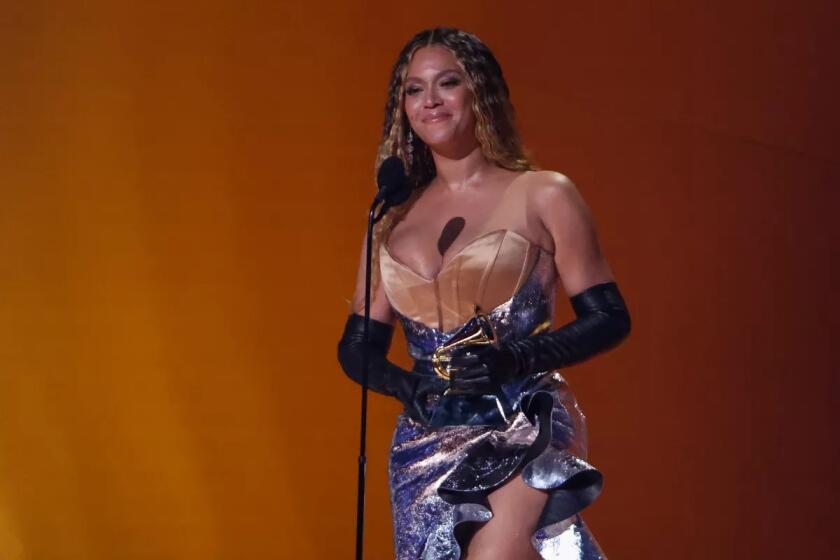Beyonce tries to have it both ways
- Share via
In the press release for her ambitious, somewhat befuddling double album -- the deluxe edition, with extra tracks, is currently streaming on her MySpace page -- Beyonce Knowles discusses her newly revealed alter ego, Sasha Fierce. “She’s the party girl, she’s Bootylicious,” says the singer-songwriter-movie star-mogulista. “She is but I’m not. She’s my alter ego. I’m finally revealing who I am.”
The contradiction built into that brief comment says much about Beyonce’s artistic predicament. A child talent-show winner molded into a pop star by her notoriously driven father, she is a creature of the stage, like Britney and Christina, the pop stars with whom she might have continued to be lumped if her father-figure husband -- and, more important, her own “rapperly” vocal gifts -- hadn’t helped her secure a spot in hip-hop’s firmament. Yet because the world of hip-hop soul expects its divas to be “real,” she’s often criticized for seeming distant within her own performances and refusing to expose herself.
For Beyonce, to say that an identity she is not is “revealing who I am” is not a contradiction. As an artist, she is a role-player first -- a brainy, often showy interpreter instead of a gut singer on ballads and a brilliantly varied rhythmic innovator on her club hits. “I Am . . . Sasha Fierce” shows her further refining both of those tendencies, and it’s full of interesting choices. But her misplaced worries about authenticity cause Beyonce to make some unfortunate missteps (mostly into the puddle of excess) that often afflict artists in mid-career.
Her first mistake, noted in other early reviews, was to separate Beyonce from Sasha and give each lady her own disc. Dispensing with the idea that the one sharing her name is any more genuine makes it clear that Beyonce has accepted standard thinking about what “real” is for a woman.
For T.I. (the other hip-hop star who recently tried this schizophrenia thing) real-versus-fake meant thug-versus-pop star, and ultimately the two were inseparable. But that’s the male rapper’s version of this struggle -- the ascendant entrepreneur trying to reconcile with the streetwise, marginalized youth still fighting for control of his psyche. (That’s also the Jay-Z story, so B knows it well.)
Might as well quote B herself (or whoever wrote the lines -- she had many collaborators, as always) to define the split she makes. “My heart used to be cold till your hands laid on my soul,” she intones in “That’s Why You’re Beautiful,” in which she compares herself to a diamond that finds its sparkle only when bought. This is the “real” Beyonce -- romantic, interdependent, brought to life by love. Her modus operandus is the power ballad.
Then there’s Sasha, whose manifesto is the Lil Wayne-inspired “Diva,” anchored around the line, “Diva is the female version of a hustla.” She is nobody’s baby, and if she finds love in the club, she’s not necessarily dirtying her apartment with it after closing hours.
Her motif is the club banger -- electro elements optional. When she does go into mid-tempo territory -- say, on the R. Kelly-meets-Rihanna vocal workout “Hello” or on “Ego,” in which B shows off the spunk she developed playing Etta James in the upcoming movie “Cadillac Records” (much to longtime James supporter Christina Aguilera’s chagrin, we’re sure ) -- Sasha’s still all about sonic complexity and challenging singing, rather than the cleaner, more open style of the Beyonce tracks.
The weirdest thing about this split is its racial undertone. The Beyonce ballads fall into that soft-rock zone that incorporates elements of crossover country, Celine-and-Whitney style divadom and U2-derived guitar hymnody. They’re vehemently not R&B;, and Beyonce enunciates them in a firmly post-racial style, in the same ballpark as her multi-culti rivals Alicia Keys and Leona Lewis. (“Halo,” written by the hip-hop world’s latest rock crush, Ryan Tedder, was originally intended for Lewis.)
There’s also the clear influence of Beyonce’s idol, Barbra Streisand. The cowriters on these songs are mostly white, though Babyface, long soul’s ambassador to soft rock, makes an appearance. The unrelenting uplift of these tracks conjures thoughts of transcendence, and that universal tone is vehemently not grounded in a “black” sound.
Sasha Fierce, on the other hand, knows where her home is. Enlisting top urban music producers, including Rodney “Darkchild” Jerkins, Sean Garrett and Jim Jonsin (who’s white, but a veteran of Flo Rida’s dirty rap scene), she stars in songs that manically reference the current lingo of the dance floor and the mix tape.
As a vocalist, Beyonce seems more comfortable in Sasha’s stilettos. Her performances on those cuts feel unforced and fun, as if she’s thinking on her feet. Stretching for deep meaning on the Beyonce ballads, she risks sounding ponderous -- communicating thoughtfulness weighs her down. Still, when she finds the right balance, as on the first single “If I Were a Boy,” she can be exquisite -- accessing the timeless quality she’s clearly bent on mastering.
So consider “I Am . . . Sasha Fierce” Beyonce’s Obama album. Through it, she is imagining a pop sound that doesn’t foreground race but still respects its roots in the black community. She’s not there yet, but the effort is fascinating, and hopefully she will keep on this path. After all, the Obama that Beyonce invokes with the name of her alter ego is still only a child.
--
More to Read
The biggest entertainment stories
Get our big stories about Hollywood, film, television, music, arts, culture and more right in your inbox as soon as they publish.
You may occasionally receive promotional content from the Los Angeles Times.










